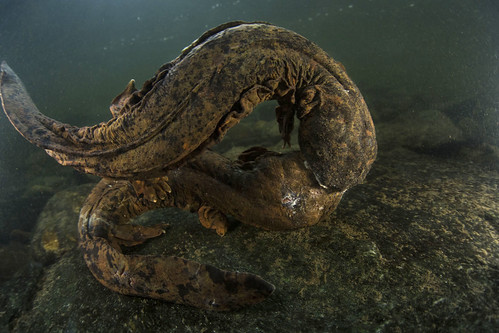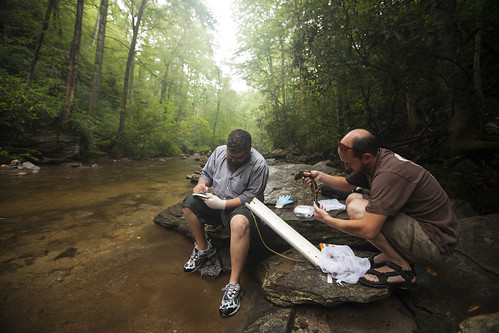
The Eastern hellbender is the largest salamander in North America, reaching lengths of up to 24 inches. Hellbenders need clean streams with high water quality and silt-free streambeds to find their prey and avoid predators. (Copyright photo courtesy Freshwaters Illustrated/Dave Herasimtschuk)
Hiding beneath a pile of rocks in a clear mountain stream flowing from the Pisgah National Forest in North Carolina lurks North America’s largest salamander, the Eastern hellbender. It is also locked in battle between its perilous decline and valiant struggle for survival.
Sediment from runoff, prescription and over-the-counter therapeutic and veterinary drugs, personal care products such as soaps, fragrances and cosmetics, other chemical pollutants, and the physical disturbance of its rocky lairs by unknowing recreationalists are all suspects contributing to the hellbender’s decline.
“This iconic symbol for Appalachia’s mountain streams is a timely ambassador for a healthy aquatic ecosystem,” said Lorie Stroup, a fisheries biologist on the Pisgah.
Until recently, this roughly 2-foot long mysterious brown, mottled and wrinkly creature was often misunderstood and even feared. Now, due in part to Forest Service conservation efforts, the fate of this old, native inhabitant now hinges on continued awareness to protect its indigenous habitat.

Lorie Stroup, Forest Service biologist on the Pisgah National Forest, installs a sign to remind forest users about the sensitivity of streambed habitats. (Copyright photo courtesy Freshwaters Illustrated/Dave Herasimtschuk)
Examples of this fascinating and declining species are seen thriving in some remaining pristine steams in a new film by Freshwaters Illustrated, which collaborated with state and Forest Service biologists. “The Last Dragons: Protecting Appalachia’s Hellbenders” provides rare and dramatic footage of this elusive creature, which is now threatening to disappear after eons of thriving in the clean, rocky waters.
This ancient nocturnal amphibian often hides under the same rock for its entire adult life span – up to 30 years – emerging at night to feed largely on crayfish. It breathes through folds of skin along its sides and, while harmless to people, suggests you may be encountering a creature from “The Lord of the Rings.” The hellbender boasts an ancient lineage, remaining largely unchanged since the age of the dinosaurs and for millions of years has found a home in the waters of Appalachia.
“Even though they are these giant salamanders, they blend right into the bottom,” said Jeff Humphries, a wildlife biologist with the North Carolina Wildlife Resources Commission. “People often float right over top of two-foot salamanders and never notice.”

Two male hellbenders locked in a battle for dominance. Hellbenders need clean streams with high water quality and silt-free streambeds to find their prey and avoid predators. (Copyright photo courtesy Freshwaters Illustrated/Dave Herasimtschuk)
In recent efforts, Forest Service biologists who manage these waters have reached out to educate the thousands of people who enjoy the same streams while swimming, tubing and boating. Those same recreationists unknowingly disturb and destroy hellbender habitat by moving rocks on the stream bottom.
“We started about 10 years ago by posting signs saying ‘Don’t move the rocks’ to help educate people about how the hellbender uses the entire ecosystem these rocks provide for food and shelter,” said Stroup. “And we’ve really had a good response. These awesome animals need to have their homes beneath the stream rocks to remain undisturbed and intact.”
Biologists are looking to the hellbender as an indicator species, a highly sensitive organism that reacts to pollution levels in air, soil or in this case water. They are often among the most sensitive species in a region, and can act as an early warning to monitoring biologists. Increases or decreases in their numbers often indicate if an ecosystem is intact or failing.
The Forest Service efforts are helping the mysterious hellbender retain its rightful role as an indicator of high water quality and an intact aquatic ecosystem.
“We want people to enjoy the rivers,” Stroup said. “I did the same thing as a kid. I was out splashing in the creeks and swimming and fishing. That’s really where I got the love of water myself. So we want people out and being able to enjoy the resource, but we want them to leave it as they found it. It’s one thing to skip a stone with your child, but it’s another thing when you’re starting to move hundreds of rocks to build a dam or build some kind of chute to get a tube down.”
The Ozark hellbender, another subspecies, is already listed under the Endangered Species Act. Commonly found in the 1970s, the Ozark hellbender remains in only a handful of pristine waterways on the Mark Twain National Forest. Scientists have yet to determine that hellbender’s alarming failure to reproduce.
The hellbender, historically found from southern New York to eastern Missouri, still maintains healthy populations within the pristine streams of several national forests in the East. Efforts by these forests to prevent siltation of stream habitat through best management practices, protection of large blocks of healthy forest, and now managing recreational use and alteration of streams bodes well for protecting the last remaining pristine Appalachian streams.
“This is all about thinking about the resource,” Stroup adds. “A focus on healthy watersheds is important for the water we drink and keeping the streams healthy for organisms such as hellbenders. Protecting and restoring our streams provides a better habitat for everything.”
Read about another innovative river conservation program and snorkeling to view amazing biodiversity on the Cherokee National Forest.

From left, biologist Jeff Humphries and field technician Michael Sisson, both with the North Carolina Wildlife Resources Commission, monitor hellbender populations in a Pisgah National Forest stream. (Copyright photo courtesy Freshwaters Illustrated/Dave Herasimtschuk)
No comments:
Post a Comment
Note: Only a member of this blog may post a comment.